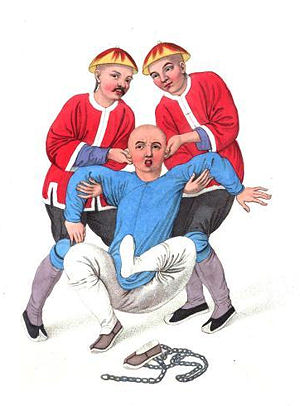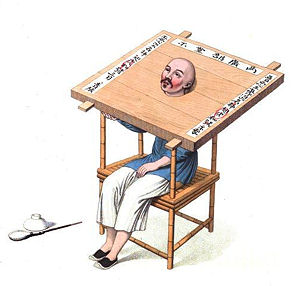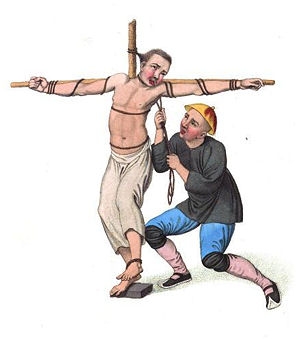From the Library -
Len Mullenger
George Henry Mason
The punishments of China (1801)
The library also has a copy of
The costume of China (1800 reprinted 1822)
We have all heard that the Charlecote Library had a
book on punishments used in China but how many of us have actually seen
it? And who was George Henry Mason? The sole biographical detail I have
found comes from the title page of The Costume of China: George
Henry Mason, Esquire, Major of His Majesty's (late) 102d regiment.
The Costume of China is the larger book, 136 pages with 60 illustrations;
the punishments of China having 56 pages and 22 illustrations. Both
books parallel English and French text on alternate pages.
The sample texts below are taken directly from the
book (including the punctuation)
PUNISHMENT OF THE SWING

This man is suspended by his shoulders and ankles, in a very painful
situation: at intervals, two attending officers afford some trifling
alleviation of his sufferings, by supporting him with a bamboo, passed
under his breast. Pencil, ink and paper, are ready, to note down whatever
he may say.
This punishment ... is chiefly inflicted upon such merchants as have
been detected in committing frauds, impositions or any other unwarrantable
tricks of the trade.
TWISTING A MAN’S EARS

He is held securely by two men, in the service of a tribunal, who are
instructed to give pain, by a particular method of twisting the cartilages
of the ear.
THE PUNISHMENT OF THE WOODEN COLLAR

This punishment is deemed very disgraceful. The collar is formed of
heavy pieces of wood, closed together, and having a hole in the centre,
which fits the neck of the offender, who, when this machine is upon
him, can neither see his own feet, nor put his hands to his mouth. He
is not permitted to reside in any habitation, nor even to take rest
for any considerable length of time; an inferior officer of justice
constantly attending, to prevent him. By night and by day, he carries
this load, which is heavier or lighter, according to the nature of the
crime, and the strength of the wearer. The weight of the common sort
of these wooden collars, is only fifty or sixty pounds, but there are
those which weigh two hundred, and which are so grievous to the bearer
that sometimes, through shame, pain, want of proper nourishment, or
of natural rest, they have been known to expire under them. The criminals
find various methods, however, of mitigating this punishment: by walking
in company with their relations and friends, who support the corners
of the collar, and prevent it from pressing upon the shoulders; by resting
it upon a table, a bench or against a tree; or, according to the representation
in the accompanying plate , by having a chair constructed for the purpose,
with four posts of equal height to support the machine. When this ponderous
encumbrance is fixed upon an offender, it is always before the magistrate
who has decreed it; and upon each side, over the place where the wood
is joined, long slips of paper are pasted, upon which the name of the
person, the crime he has committed, and the duration of his punishment,
are written, in very distinct characters; a seal is likewise stamped
upon the paper, to prevent the instrument from being opened. Three months
is the usual time appointed for those to bear this collar, who have
been convicted of robbery. For defamation, gambling, or breaches of
the peace, it is carried a few weeks; and insolvent debtors are sometimes
ordered to bear it, until they have satisfied their creditors.
THE CAPITAL PUNISHMENT OF THE CHORD

The usual capital punishments in China are, standing and beheading.
The former is the most common, and is decreed against those, who are
found guilty of crimes, which, however capital, are only held in the
second rank of the atrocity. For instance, all acts of homicide, whether
intentional or accidental; every species of fraud, committed upon the
government: the seduction of a woman, whether married or single; giving
abusive language to a parent, plundering or defacing a burying-place;
robbing with destructive weapons, and for wearing pearls. It would not,
perhaps, be possible to form any probable conjecture of the motive,
which has induced the Chinese legislators to attach the pain of death
to the wearing of a precious gem. The fact is, therefore, only stated
from the information of various writers, and remains to be explained
by some future commentator.
Criminals are sometimes strangled with a bow-string; but on general
occasions a cord is made use of, which fastens the person to a cross,
and one turn being taken round his neck, it is drawn tight by an athletic
executioner.
Men of distinction are usually strangled; and where the Emperor is inclined
to show an extraordinary mark of attention towards a mandarin condemned
to die, he sends him a silken cord, with permission to be his own executioner.
Len Mullenger is a Sunday volunteer guide. Any comments
are welcome and can be sent to len@musicweb-international.com
All articles can be seen at http://www.musicweb-international.com/Charlecote





